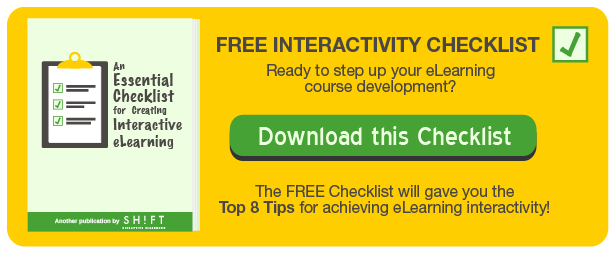Creating effective and engaging eLearning course is much easier said than done. That's why in this post, we'll review five best practices every eLearning professional should master perfectly.
Here are our five top tips to help you build better eLearning courses:
1) Include All Critical Elements of an Effective eLearning Course
In order to make effective eLearning courses, it’s critically important that they consist of the following components:
-
A clear, attention-grabbing introduction
-
A fully functional learner interface
-
Provides a lot of user-friendly support and communication
-
Comprehensive yet relevant content
-
Simple and clear language
-
Attractive and relevant visual elements
-
Compelling call-to-actions
-
Balanced interactivity
-
Continuous assessments and knowledge checks
2) Remember: Less Is More
Many of you are probably aware of the phrase “keep it simple, stupid.” Apply that same philosophy to your eLearning courses. Make it easy on the eyes. A cluttered screen only causes distraction, confusion and boredom. Instead, embrace white space, and keep the text and images on the screen simple and to-the-point. Say no to busy backgrounds, distracting media, and color schemes with more than six colors.
3) Consider the impact of good visual design
 Many times, eLearning professionals responsible for creating courseware don't put enough attention on visual design. And guess what? First impressions definitely matter in eLearning. It takes only 1/10th of a second to form a first impression about a person, and in eLearning this work equally.
Many times, eLearning professionals responsible for creating courseware don't put enough attention on visual design. And guess what? First impressions definitely matter in eLearning. It takes only 1/10th of a second to form a first impression about a person, and in eLearning this work equally.
It's also proven that in Web Design first impressions are 94% design related. Therefore, learning some basic visual design principles is fundamental. For example, consider factors such as position, color, contrast, spacing, and alignment. Everything you add to your course conveys a meaning, so make sure everything you include is important enough to be there.
4) Emphasize the course's value
eLearning courses need to offer more than just a list of course objectives. The best courses highlight and reinforce the course's value on a constant basis. They give learners clear and compelling reasons why the content is so imporant for them to learn. If the course doesn't answer the “What’s in it for me?” from the beginning, learners will not be interested or motivated to continue, no matter how great it looks. If you manage to grab learners’ attention from the start and consistently remember the WIIFM, you’ll succeed.
5) Create flexible and digestible modules
You might be wondering how long or how short your eLearning courses should be. Unfourtunately, there is no right or wrong answer to this. What you definitely must do is incorporate only the information you REALLY need. Instead of worrying about time, your course should be focus on including actionable, digestible, and leaner-centered content. With out doubt, flexible and adaptable learning modules adapt to the needs of even the busiest employee.
What other tips would you share with other eLearning professionals taking an interest in improving their eLearning courses?




